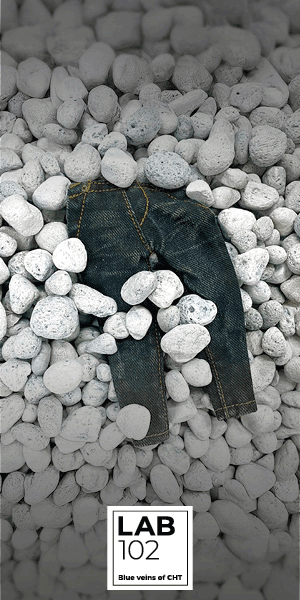Ikeme Eshemokhai: Relationships are the strongest asset

We speak to Ikeme Eshemokhai for the first in our series of interviews with denim specialists who go the extra mile
Ikeme is a denim specialist who has worked with some of the biggest fast fashion retailers and premium denim brands and has always had an interest in the social aspect of denim and its cultural impact. Having lived in six countries spanning four continents, she has witnessed the universal language of a pair of jeans, with its cultural status, and how we are deeply connected by its history. She has worked with some of the most renowned denim innovators in the industry and she continually pushes for sustainable innovation and transparency. She resides with her husband in Barcelona, Spain.
Q What have you been most proud of in terms of what you’ve achieved in your roles?
A Pushing the conversation on sustainability long before it became a focus for most brands. Being part of this particular industry, I’ve always been very aware of the polluting impact the production of jeans entailed. Early on I developed hang tags in collaboration with Lenzing explaining what sustainable fibres such as Tencel and ProModal are and how they are produced. And I have worked with some of the best laundries on producing vintage washes with more eco-efficient wash processes. I am also very involved with fabric development and constantly working with mills on fabric innovation.
What requests do you make of partners in terms of sustainability and what might attract you to new suppliers?
It is important that laundries invest in the latest wash technology to reduce the pollution caused by denim garment manufacturing. It also goes without saying that laundries should have a water recycling plant. For some time now, mills have been working on various new ways of reducing their carbon footprint by developing sustainable fabrics in terms of fibre content, as well as dyeing and finishing processes.
To be honest the first thing that attracts me to a new supplier, be it a mill, a trim supplier or a garment manufacturer, is the quality of the product and if it sets itself apart from other suppliers. Thus, innovation is definitely key. However, what good is the most sustainable product if it does not look nice and is marketable or commercial to a certain degree? In this sense, apart from expecting newness, i.e. in fabrics, it is extremely important that the fabrics can still be washed in the laundry and different wash effects can be achieved unless the intent is a very clean look. Sometimes the fabric is so far removed from what defines a “denim” fabric. When it starts crossing over too much in a different segment such as sportswear it definitely becomes somewhat problematic, because there are specialists who focus on fabrics for that segment and you find yourself entering another realm of competition.
In terms of garment manufacturers and laundries, what attracts me the most is the workmanship and the capabilities which depend on the skillset of the people who work in the industry. The people are the most important and most valuable component in the process of bringing life to the designs I create.
How do you go about achieving the correct look for your designs and how does your relationships in the supply chain help you to achieve this?
I am very old school in this aspect, I guess. I like to travel and visit the suppliers. I work directly with the people who are responsible for engineering the final product, meaning I work directly with the laundry technician, explaining what is required to achieve the desired look.
I believe it is the relationship you have with the people you work with that defines the outcome of the design. We form a big team with all of the people who are involved in the making of a denim garment and the design cannot come to fruition without all of the amazing talent who work in the supply chain.
What kind of conversations go on within brands about price versus sustainability? Could brands afford to lose a little margin help manufacturers invest in new technologies or the workforce?
This is a very complex question. It depends on what the overall objective is of the specific brand. You will encounter very different approaches from brand to brand. I strongly believe that brands could afford to lose a little margin. At the end of the day it should go without saying that the manufacturing process of fabrics, trims and garments should be more sustainable to the environment. It should be intrinsic to the industry without the need of having to market it.
How hard is it for designers to keep producing new products and to generate increased sales?
I personally think it is not very difficult to come up with new products as a designer. However, to generate increasing sales is another point of discussion, especially for brands that are afraid of taking risks. Understandably, the fashion industry as a whole has been in a rather difficult state.
Apart from political and economic factors, consumer spending habits have changed in recent years. Consumers have stopped spending money on fashion apparel how they used to, but are now rather spending it on experiences and new tech. Hence, visual merchandising, e-commerce and in-store experience have been becoming increasingly more important over the last couple of years. But in the US and Europe for the most part brands have been slow to react, whereas in Asia brands have been much faster to adapt by offering super apps for a convenient online shopping experience and a fantastic in-store visual merchandising experience.
Whose responsibility is it to educate consumers about the jeans they wear and drive demand for sustainability (which will eventually mean higher prices)?
It is always the responsibility of the brands and manufacturers to push the conversation and demand for sustainability, even though most consumers nowadays are demanding transparency and increasingly informed about manufacturing processes.
It does not necessarily mean the prices have to be higher. If the change towards sustainability becomes a norm, prices of raw materials should become standardised. If the brands are willing to accept a slightly lower margin this would help to maintain prices.
How do you see the industry evolving? What are the main obstacles?
The industry will only evolve if there is a push for innovation. It needs to stop being reactive and instead become more proactive. There needs to be a serious discussion on how to engineer a product which is not only sustainable but can be ethically produced. Very often this part of the discussion gets lost when talking about eco-friendly production. It is equally or possibly even more important to the socially conscious minded consumer to know if the garment she/he purchased was made by a fairly compensated factory worker in a safe environment.
More importantly, brands need to refocus on identifying their core product ranges as well as who their target customer is. Some of the fastest growing economies are not Western economies. Hence, it is important for brands to truly understand the customers who have increasing buying power.
Unfortunately, as numerous faux pas have proved with some of the advertising campaigns of global brands, there is still a very real lack of inclusion and diversity happening in the headquarters of these brands.













